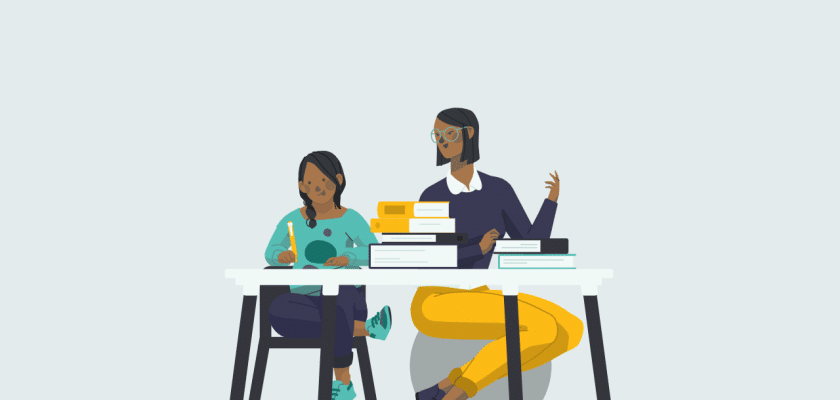Whether it’s an elementary student enjoying a good book, a parent diving into a novel before bedtime, or a college student cramming course material, reading is an essential part of life. It’s a fundamental daily skill, yet it doesn’t come naturally for some.
Have you heard the phrase “active reading” before? You may not realize that some habits you already do are considered active reading strategies. Essentially, active reading is a way of reading that engages the reader with the text. Rather than reading passively, which can lead to confusion and forgetting what was read, active reading strategies help readers focus, comprehend, and remember what they read.
More specifically, there are strategies that readers can do before, during, and after the text to have a deeper understanding of the content. Utilizing active reading strategies could give teenagers and even young adults more interest in reading. According to the American Psychological Association (APA), only about 20 percent of teenagers read some form of literary material daily, whether it be a book, magazine, or even a menu from a restaurant.
Using these techniques could help readers of all ages view reading as something they thoroughly enjoy rather than something that “needs to get done.” When reading is viewed through a lens like this, it becomes a pastime that can be done for fun, to learn new information, or both: not a chore or assignment that creates stress and frustration.
Table of Contents
- What Does An Active Reader Do?
- Active Reading Strategies for Pre-Reading
- Active Reading Strategies for Post-Reading
- Incorporating Active Reading Strategies In An Educational Setting
- Be A More Effective Reader
- Active Reading Strategies FAQ’s
- Active Reading Takeaways
What Does An Active Reader Do?
It’s important to note that there are several proven active reading strategies, but they could really be anything that works for the reader. If a particular method helps somebody focus and engage with the text, then it is considered one. Readers should engage in specific activities before, during, and after reading text to truly grasp what they read.
Some pre-reading active reading strategies include the following:

Active Reading Strategies for Pre-Reading
Making a KWL Chart or Anticipation Guide:
A KWL chart is a chart that has three columns comprised of what you know, what questions do you have about the topic, and what you learned (to be filled out after reading). Anticipation guides are charts with a series of statements related to the text. The reader agrees or disagrees with each statement and writes down their reasoning for why they feel that way. Both of these charts are used to help readers focus on what they already know about a topic help establish a purpose in reading.
Taking a Picture Walk:
Readers will skim a text by looking at illustrations or photographs of the text. Then, they’ll write a prediction in a reader’s journal to justify and confirm what they thought would happen.
As the reader is engaged in the text, they can use strategies to make reading more enjoyable and effective. One of the most effective is actively taking notes. This technique can be used in various ways, whether taking notes in the margins, jotting important points on index cards, or just writing a summary of what was read periodically, such as after every chapter.
Asking Questions:
Effective readers also ask plenty of questions as they read, which is why it’s another great strategy to use. For example, you could be reading an intriguing novel mystery, and a key piece of evidence is discovered. The reader could then ask themselves questions such as “What does this mean?” or “How will this affect the outcome?” These questions could quickly be jotted down along the margin, similar to your note-taking strategy.
Mental Imagery:
Making mental pictures as you read, or what we refer to as visualizing the text, can also be considered an active reading strategy because it forces the reader to use more than one sense while reading. This, in turn, deepens comprehension because it engages more of the brain. Long chapter books with limited pictures are good candidates for this strategy.

Active Reading Strategies for Post-Reading
Once you have finished reading a text, it’s also vital to consider some strategies to deepen your understanding of what you’ve read, or otherwise referred to as post-reading strategies.
Verbal Retelling:
One example is a verbal retelling of the story to a friend or classmate. By using this strategy, you’re summarizing critical points of the text, whether it’s informational or literary. It can help to identify what you think are the most essential details in the story. You can also use this strategy by writing a summary of what you read in a reader’s journal or another type of notebook.
Frayer Model:
Utilizing a Frayer model is also an excellent technique to use after reading because it can delve deeper into academic vocabulary that was challenging to understand. Here is an example with the word democracy. The reader would write the word democracy into the center of a grid with four quadrants. In one section, the word would be defined in the reader’s own words. Another section would include characteristics of the vocabulary word. The third quadrant would give examples of the vocabulary word, and the final section would consist of non-examples. It creates a better way to understand more difficult words rather than rote memorization.
These examples of active reading have been used in classrooms and proven to be effective techniques for improving reading comprehension. However, as we mentioned earlier, anything the reader does to enhance their understanding of the text can be considered an active reading strategy. The key piece of information to realize is that an active reading strategy makes the reader take control of what they’re reading and how they understand it.

Incorporating Active Reading Strategies In An Educational Setting
Now that we’ve learned a little about some of the most used active reading strategies, the point of concern is how to use them effectively in classroom environments.
Just like any other skill or strategy parents or teachers introduce to their kids, it’s important to establish norms beforehand. Norms are the assumptions we make in order to keep things organized and satisfy a shared objective. Here, the goal is for our students (or kids) is not only to try but to use active reading strategies effectively. Here, the norms should include:
- Asking appropriate questions about how to use the process.
- Encourage participation.
- Ask for help when something is unclear.
Next, teachers should establish procedures of what to do when the strategy is incorporated. Procedures are a list of precise instructions that must be followed for an activity to be completed. For this example, it’s critical to focus on a single strategy at a time, or you run the risk of confusion and/or incorrect implementation.
Explicit Modelling:
Explicit modelling should always be done first by the teacher with think-alouds (metacognition) to let your classroom know precisely what your intentions are and how the strategy will be used. If we go back to the note-taking example, the teacher would first model how to take notes using a specific format with a particular text.
Switch Roles:
Once students try the strategy for the first time, the teacher would switch roles to become the facilitator. In the classroom setting, this could be the adult walking around the classroom during reading time using reinforcement, reteaching if necessary, or answering questions students may have. A slow, gradual release with students taking more ownership of the strategy will let the teacher know the right time when another one can be introduced. Eventually, they’ll have an entire arsenal of effective strategies to become better, more confident readers.
Paring Off:
One thing that makes active reading good is the flexibility of trying it individually, with partners, or even in a group setting. For instance, if students were paired up reading the same story, they could be asked to implement one of the strategies above, such as a KWL chart. Students could compare their K and W sections together before reading. Then, after reading, they could complete the L section and share what they learned with each other. Thoughtful engagement is imperative if you want your readers to be involved in the learning process throughout the day.
Utilize Technology:
Utilizing technology should also be considered as more classrooms are equipped with learning devices, such as Chromebooks or I-pads, even a 1:1 ratio for some schools. Google apps for education, Kahoot games, Quizziz, Wordles, and Padlet walls are just a few ways of how technology is used to incorporate active reading strategies in a digital setting.
Here is an example of how it would look with Kahoot. After the teacher has modeled and introduced the active reading strategies, Kahoot can be used to reinforce the techniques learned. A Kahoot game can easily be created ahead of time and doesn’t take long. Teachers can quickly go over how to play the game by choosing the correct responses as quickly as possible on their devices. Technology is good for encouraging friendly competition while providing valuable feedback for the teacher.

Be A More Effective Reader
Like anything else, you can hone your craft and become a more effective reader with practice. You could start by asking yourself some pre-reading questions, such as “What is the purpose of this text?” or “What will this story be about?” Then, as your read, you can identify and define words you come across that you don’t know. Don’t just skim over them; take the time to look up their definitions or synonyms to grasp the meaning. Earlier, we discussed asking questions as you read. If you can’t answer the question, chances are you need to reread that section.
Many people like to utilize highlighting or bracketing blocks of text while they read, too because it allows them to go back and reread the section if they need to. This strategy can also help the reader refer to those sections as a reference later on and can help summarize the text as needed.
Becoming an effective active reader does take a lot of practice, but it becomes natural once you’ve mastered the strategies. You’ll find yourself more inclined to read more challenging books or topics and you might even discover new topics that you otherwise might not have been interested in.
Active Reading Strategies FAQ’s
Active reading strategies are any technique that a reader uses to increase their comprehension of a text. Some common active reading strategies include: highlighting or underlining key points, taking notes while reading, rereading difficult sections, and asking questions about the text. These strategies can be used interchangeably while reading.
Active readers have more of an opportunity to actively engage with the text, which can lead to a better understanding of the material. As a result, using active reading strategies can help you digest imperative information more clearly.
Active reading has been proven to help readers of all ages interact with text better. They can use a combination of strategies to become better readers.
Active reading is more engaging and interactive, while passive reading is simply moving your eyes over the text. When you are actively reading, you are using techniques to better understand and remember the material, while passive reading does not involve these same comprehension strategies.
Active Reading Takeaways
- Active reading is a strategy that helps readers become more involved with the text and think more critically.
- There are proven techniques that are considered active reading strategies, but anything that encourages deeper thinking and engagement could be regarded as a strategy.
- Slowly integrate active reading techniques in a classroom, beginning with explicit monitoring all the way to independent mastery.
- There are an array of reading skills that can be used to make the process more effective.
